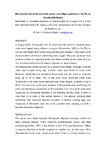Movements of juvenile and adult spider crab ("Maja squinado") in the Ría da Coruña (NW Spain)

Use este enlace para citar
http://hdl.handle.net/2183/123Colecciones
- Investigación (FCIE) [1227]
Metadatos
Mostrar el registro completo del ítemTítulo
Movements of juvenile and adult spider crab ("Maja squinado") in the Ría da Coruña (NW Spain)Autor(es)
Fecha
2003Resumen
[Abstract] In August 2002, 12 juvenile and 12 adult (recently terminal moulted) spider
crabs were tagged using ultrasonic pingers (Sonotronics, USA) in the Ría da
Coruña (NW Spain). Both adults and juveniles were released in the same sandy
shallow bottoms (5-10 m) in which they were caught. This area, as known from
previous studies, is a typical juvenile area where juvenile spider crabs carry out
their terminal moult before the autumn migration to deep bottoms.
The tracking was carried out daily for a period of two weeks, although not all the
crabs were located every day. Juvenile crabs were found to move small
distances, performing non-directional movements near the coast, in protected
areas up to 10 m deep. Two of the adult crabs performed small scale
movements in the outer (more exposed) part of the estuary, at depths of up to
20 m. The rest of the adult crabs remained in the juvenile area, performing the
same non-directional movements as the juveniles. Four male adult crabs were
recaptured by commercial fisheries in the following months, three of them at
more than 40 m deep, in the central channel of the estuary, probably while
performing their seasonal descent migration. A female carrying eggs was
recaptured in December near the coast, probably after carrying out both a
descent and ascent migration.
Descripción
Presentado no Fifth Conference on Fish Telemetry held in Europe, 9-13 June 2003, Ustica, Palermo, Italy





